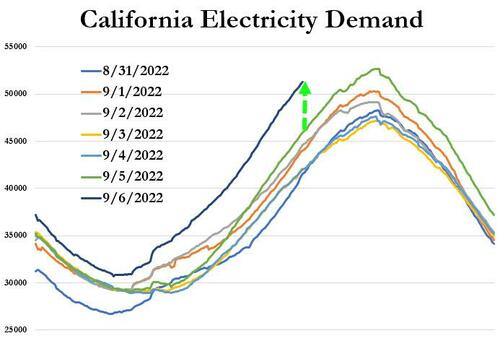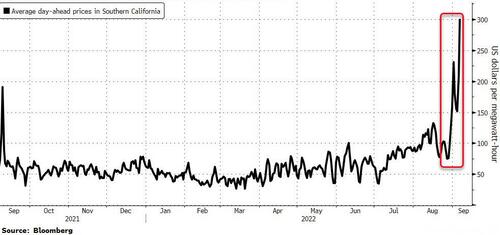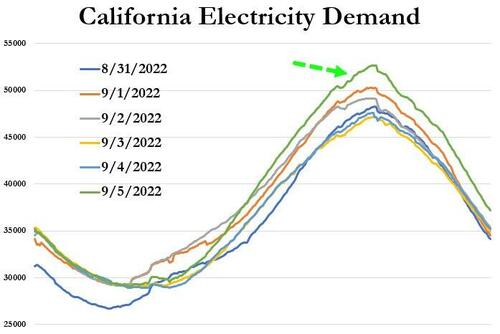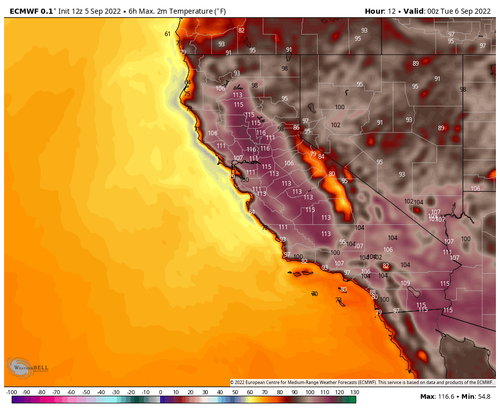
Update (1400ET): As we warned about earlier, Califiornians are apparently not heeding officials' warnings that they should sacrifice their comfort for the sake of whatever business or social-engineering plan is the new thing.
CAISO shows that usage is up 13% today from yesterday at the same time of day and for a second consecutive day, the state’s grid operator issued a level-2 energy emergency alert.
The emergency declaration allows officials to order some large power consumers to shut down in a last-ditch effort to avoid outages.
“We are heading into the worst part of this heat wave, and the risk for outages is real and it’s immediate,” California Governor Gavin Newsom said in a video posted Tuesday on Twitter. He urged residents and businesses to cut back on energy use during the late afternoon and early evening to help the state avoid outages.
And average day-ahead prices for power on Tuesday in the southern part of the state surged 44% to $300.55 a megawatt-hour, the highest in 18 months.
With heat soaring things are only likely to get worse:
“We’re looking at a lot of records today,” said Bob Oravec, a senior branch forecaster at the US Weather Prediction Center.
“They are having a lot of issues with power out there, and this isn’t going to help.”
* * *
California narrowly avoided rotating outages on Monday while power grid officials asked customers to conserve electricity amid a record-breaking heatwave.
The prospect of outages did not bother Californians. Many customers continued to use appliances, air conditioning, and at-home electric vehicle chargers despite conservation pleas from California Independent System Operator (CAISO).
Monday was the fifth straight day CAISO warned about a blistering heat wave that pushed its electric system to the brink. Even though no widespread blackouts were reported, electricity demand surged to one of the highest levels (52,646 megawatts), outlining how customers widely ignored conservation calls.
A Reuters report showed soaring demand for electricity sent power prices in the state to the highest levels since August 2020.
Power prices at the Palo Verde hub in Arizona and SP-15 in Southern California rose to $850 and $505 per megawatt hour, respectively. That was their highest levels since hitting record highs of $1,311 in Palo Verde and $698 in SP-15 in August 2020 when the ISO last imposed rotating outages.
CAISO predicts demand could reach all-time high levels today as homes and businesses turn their thermostats down to escape triple-digit temperatures.
And since Californians aren't conserving electricity as demand steadily rises, this could mean CAISO would instruct utilities to start imposing rotating outages if duress on the grid continued -- maybe then, after the fact, customers will get the message to conserve.
Elliot Mainzer, CEO of CASIO, said Monday: "We need a reduction in energy use that is two or three times greater than what we've seen so far as this historic heat wave continues to intensify."
Update (1400ET): As we warned about earlier, Califiornians are apparently not heeding officials’ warnings that they should sacrifice their comfort for the sake of whatever business or social-engineering plan is the new thing.
CAISO shows that usage is up 13% today from yesterday at the same time of day and for a second consecutive day, the state’s grid operator issued a level-2 energy emergency alert.
The emergency declaration allows officials to order some large power consumers to shut down in a last-ditch effort to avoid outages.
“We are heading into the worst part of this heat wave, and the risk for outages is real and it’s immediate,” California Governor Gavin Newsom said in a video posted Tuesday on Twitter. He urged residents and businesses to cut back on energy use during the late afternoon and early evening to help the state avoid outages.
And average day-ahead prices for power on Tuesday in the southern part of the state surged 44% to $300.55 a megawatt-hour, the highest in 18 months.
With heat soaring things are only likely to get worse:
“We’re looking at a lot of records today,” said Bob Oravec, a senior branch forecaster at the US Weather Prediction Center.
“They are having a lot of issues with power out there, and this isn’t going to help.”
* * *
California narrowly avoided rotating outages on Monday while power grid officials asked customers to conserve electricity amid a record-breaking heatwave.
The prospect of outages did not bother Californians. Many customers continued to use appliances, air conditioning, and at-home electric vehicle chargers despite conservation pleas from California Independent System Operator (CAISO).
Monday was the fifth straight day CAISO warned about a blistering heat wave that pushed its electric system to the brink. Even though no widespread blackouts were reported, electricity demand surged to one of the highest levels (52,646 megawatts), outlining how customers widely ignored conservation calls.
A Reuters report showed soaring demand for electricity sent power prices in the state to the highest levels since August 2020.
Power prices at the Palo Verde hub in Arizona and SP-15 in Southern California rose to $850 and $505 per megawatt hour, respectively. That was their highest levels since hitting record highs of $1,311 in Palo Verde and $698 in SP-15 in August 2020 when the ISO last imposed rotating outages.
CAISO predicts demand could reach all-time high levels today as homes and businesses turn their thermostats down to escape triple-digit temperatures.
And since Californians aren’t conserving electricity as demand steadily rises, this could mean CAISO would instruct utilities to start imposing rotating outages if duress on the grid continued — maybe then, after the fact, customers will get the message to conserve.
Elliot Mainzer, CEO of CASIO, said Monday: “We need a reduction in energy use that is two or three times greater than what we’ve seen so far as this historic heat wave continues to intensify.”









